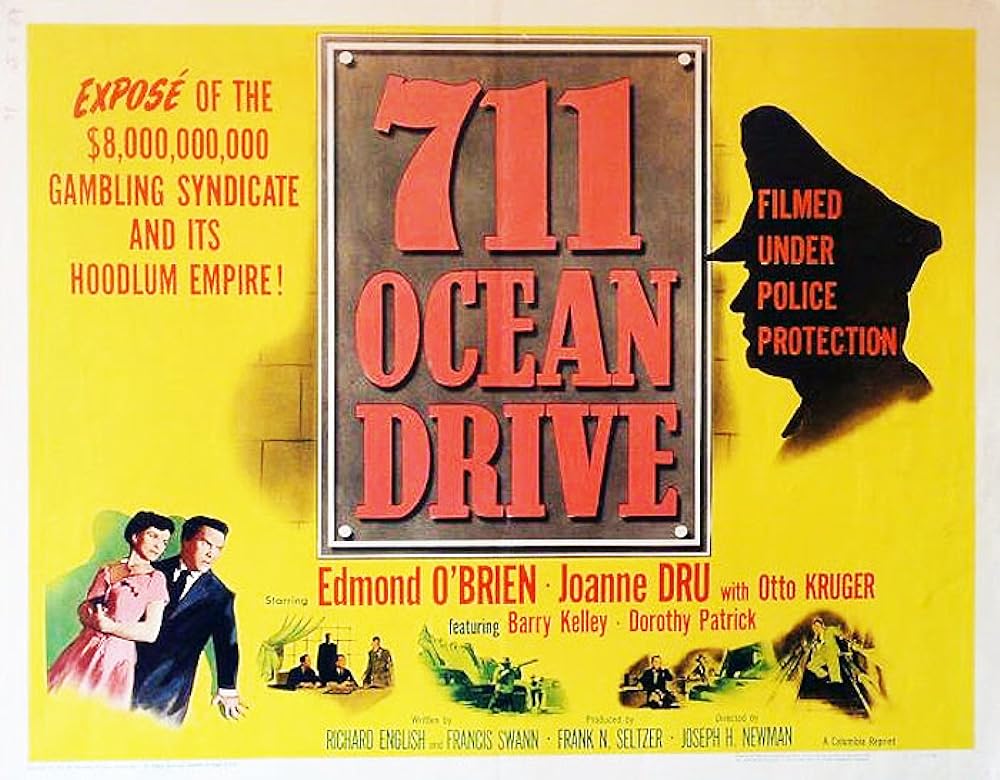Introduction:
Released in 1950, “711 Ocean Drive” stands as a captivating and seminal crime noir film directed by Joseph M. Newman. This classic movie has garnered praise for its gripping narrative, atmospheric cinematography, and stellar performances. In this comprehensive review, we delve into the intricate elements that make “711 Ocean Drive” a timeless piece of cinema, exploring its plot, characters, cinematography, themes, and its enduring impact on the crime noir genre.
Plot Summary:
The film revolves around Eddie Darrow, portrayed with compelling intensity by Edmond O’Brien, a telephone lineman who climbs the ranks of the criminal underworld. Eddie’s journey begins innocently enough, as he installs phone lines for the betting operation run by the charismatic and ruthless Vince Walters, played by the enigmatic and imposing Barry Sullivan. As Eddie becomes entangled in the web of illegal activities, he soon finds himself in a world of deceit, power struggles, and moral ambiguity.
Themes:
- Ambition and Morality: “711 Ocean Drive” explores the theme of ambition and its intersection with morality. Eddie Darrow’s rise to power is fueled by ambition, leading him down a path where ethical boundaries become increasingly blurred. The film raises questions about the choices individuals make in pursuit of success and the moral compromises that may follow.
- Power Dynamics: The narrative intricately weaves a tale of power dynamics within the criminal underworld. Vince Walters, the charismatic kingpin, exemplifies the seductive allure of power. As Eddie ascends through the ranks, the film delves into the complexities of power and the consequences of challenging authority within a criminal hierarchy.
- Betrayal and Loyalty: “711 Ocean Drive” explores the themes of betrayal and loyalty. Eddie’s journey is marked by shifting allegiances, highlighting the fragile nature of trust in a world where personal gain often supersedes loyalty. The film presents a nuanced portrayal of relationships within the criminal realm, where alliances can be both ephemeral and perilous.
Cinematography:
- Noir Aesthetics: The cinematography, steeped in classic noir aesthetics, contributes significantly to the film’s atmospheric and moody tone. Dark, shadowy visuals, low-key lighting, and evocative camera angles create an immersive experience, capturing the essence of the crime noir genre.
- Symbolism and Imagery: “711 Ocean Drive” employs symbolism and visual imagery to convey narrative subtext. The use of shadows, reflections, and framing enhances the storytelling, adding layers of meaning to the characters’ actions and the unfolding plot. The cinematography becomes a visual language that communicates the film’s thematic depth.
Characters:
- Eddie Darrow (Edmond O’Brien): Edmond O’Brien’s portrayal of Eddie Darrow is a standout performance that captures the complexity of the character. From the initial innocence to the gradual transformation into a morally conflicted figure, O’Brien’s nuanced acting lends depth and authenticity to the protagonist.
- Vince Walters (Barry Sullivan): Barry Sullivan’s portrayal of Vince Walters is magnetic. Walters is not a one-dimensional villain but a charismatic and enigmatic figure whose presence looms large over the narrative. Sullivan’s performance adds layers to the character, making Walters simultaneously captivating and menacing.
Impact and Legacy:
“711 Ocean Drive” holds a significant place in the history of crime noir cinema. Its exploration of moral ambiguity, power dynamics, and the consequences of ambition paved the way for subsequent films within the genre. The film’s enduring legacy is evident in its influence on later crime dramas, contributing to the evolution of storytelling techniques and character portrayals within the noir tradition.
Conclusion:
In conclusion, “711 Ocean Drive” (1950) remains a captivating and influential film in the crime noir genre. Its exploration of ambition, morality, and power dynamics, coupled with evocative cinematography and stellar performances, solidifies its status as a timeless classic. Joseph M. Newman’s directorial vision, coupled with the exceptional cast led by Edmond O’Brien and Barry Sullivan, creates a cinematic experience that continues to resonate with audiences, ensuring its place among the enduring gems of crime noir cinema.
